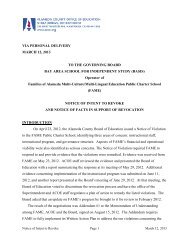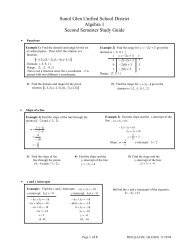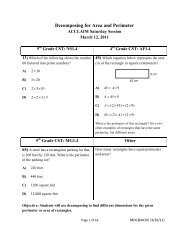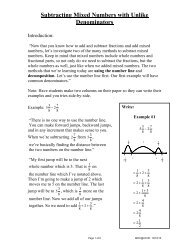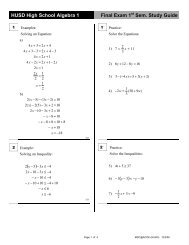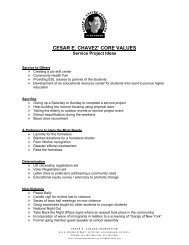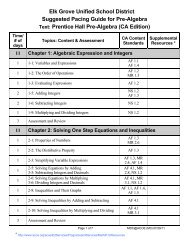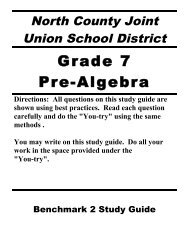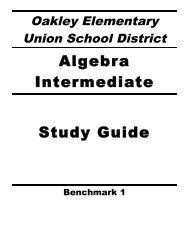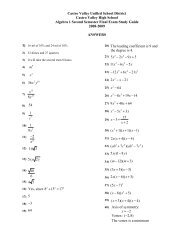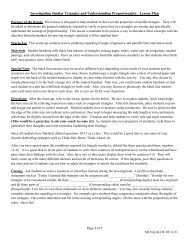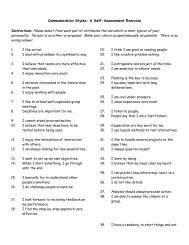Foundational Literacy Skills for EL- English Learners (CA Dept of ...
Foundational Literacy Skills for EL- English Learners (CA Dept of ...
Foundational Literacy Skills for EL- English Learners (CA Dept of ...
You also want an ePaper? Increase the reach of your titles
YUMPU automatically turns print PDFs into web optimized ePapers that Google loves.
Cali<strong>for</strong>nia Department <strong>of</strong> Education August 20, 2012<br />
<strong>Foundational</strong> <strong>Literacy</strong> <strong>Skills</strong> <strong>for</strong> <strong>English</strong> <strong>Learners</strong><br />
Introduction<br />
<strong>Foundational</strong> literacy skills—which primarily address print concepts, phonological awareness,<br />
phonics and word recognition, and fluency, as described in the <strong>CA</strong> Common Core Reading<br />
Standards (K–5)—are critical <strong>for</strong> <strong>English</strong> learners at all ages who need to learn basic literacy<br />
(August & Shanahan, 2006; Riches & Genesee, 2006). <strong>English</strong> learners face an additional<br />
challenge in developing literacy in <strong>English</strong> since they must develop oral pr<strong>of</strong>iciency in <strong>English</strong>—<br />
including depth and breadth <strong>of</strong> vocabulary—at the same time they are learning to read and<br />
write (Roessingh & Elgie, 2009; Short & Fitzsimmons, 2007; Torgesen, et al., 2007). While more<br />
research on <strong>English</strong> learner literacy is needed (IRA/NICHD, 2007), the research results available<br />
so far show that <strong>English</strong> learners can transfer native language literacy skills to <strong>English</strong> literacy<br />
learning (August & Shanahan, 2006; Riches & Genesee, 2006); thus, literacy instruction <strong>for</strong><br />
<strong>English</strong> learners will need to be adapted based on each student’s previous literacy experiences<br />
in their native language, as well as on their age and level <strong>of</strong> schooling. In designing the adapted<br />
instruction <strong>for</strong> <strong>English</strong> learners, additional individual student characteristics that need to be<br />
considered include: the student’s level <strong>of</strong> oral pr<strong>of</strong>iciency in the native language and in <strong>English</strong>;<br />
how closely the student’s native language is related to <strong>English</strong> 1 ; and, <strong>for</strong> students with native<br />
language literacy, the type <strong>of</strong> writing system used 2 .<br />
Research Summary and Implications <strong>for</strong> <strong>English</strong> <strong>Learners</strong><br />
Below is a summary <strong>of</strong> key findings from the research cited above, with implications <strong>for</strong> literacy<br />
foundational skills instruction <strong>for</strong> <strong>English</strong> learners.<br />
<br />
<strong>English</strong> <strong>Learners</strong> Benefit from Reading <strong>Foundational</strong> <strong>Skills</strong> Instruction<br />
o Research Findings: Instruction in the components <strong>of</strong> reading foundational<br />
skills—such as phonemic awareness, phonics, fluency, vocabulary, and text<br />
comprehension (NICHD, 2000)—benefits <strong>English</strong> language learners.<br />
o Implications: Instruction in literacy foundational skills is essential <strong>for</strong> <strong>English</strong><br />
learners. However, the instruction should be adjusted based on students’<br />
spoken <strong>English</strong> pr<strong>of</strong>iciency (they may or may not be familiar with the <strong>English</strong><br />
sound system) and native language or <strong>English</strong> literacy pr<strong>of</strong>iciency (they may or<br />
may not be familiar with the Latin alphabet writing system).<br />
• Indicators <strong>for</strong> intervention: Students who have learning disabilities (as<br />
diagnosed separately from their <strong>English</strong> learner designation)—or whose<br />
literacy skills in either their native language or <strong>English</strong> remain below<br />
grade level after intensive and extensive instruction—may need<br />
specialized literacy intervention services.<br />
1 For in<strong>for</strong>mation on which languages are related to each other, see the website Ethnologue:<br />
www.ethnologue.co<br />
m/web.asp<br />
2 For in<strong>for</strong>mation on writing systems <strong>for</strong> the world’s languages, see the website Omniglot:<br />
www.omniglot.com<br />
1
Oral <strong>English</strong> Language Pr<strong>of</strong>iciency is Crucial <strong>for</strong> <strong>English</strong> <strong>Literacy</strong> Learning<br />
o<br />
o<br />
Research Findings: Oral pr<strong>of</strong>iciency in <strong>English</strong> (including oral vocabulary,<br />
grammar, and listening comprehension) is critical <strong>for</strong> <strong>English</strong> learners to develop<br />
pr<strong>of</strong>iciency in text‐level <strong>English</strong> reading comprehension: word identification<br />
skills are necessary but not sufficient.<br />
Implications: Instruction <strong>for</strong> <strong>English</strong> learners in oral language knowledge, skills,<br />
and abilities must be explicit, intensive, and extensive. In order to be successful<br />
in reading <strong>English</strong>, <strong>English</strong> learners must develop pr<strong>of</strong>iciency in listening and<br />
speaking skills in <strong>English</strong>—depth and breadth <strong>of</strong> vocabulary, as well as<br />
grammatical structures—at the same time they are developing foundational<br />
skills in reading and writing <strong>English</strong>.<br />
Native Language <strong>Literacy</strong> <strong>Skills</strong> Facilitate <strong>English</strong> <strong>Literacy</strong> Learning<br />
o<br />
o<br />
o<br />
Research Findings: <strong>Learners</strong> learn to read in their native language be<strong>for</strong>e or at<br />
the same time as they are learning to read <strong>English</strong><br />
<strong>English</strong> learners’ native language literacy skills can help them learn <strong>English</strong><br />
literacy foundational skills.<br />
Implications: Instruction <strong>for</strong> <strong>English</strong> learners will need to vary based on<br />
variations among <strong>English</strong> learners’ native language writing systems, as well as<br />
<strong>English</strong> learners’ experiences with literacy in their native language. For example,<br />
students who are literate in a language that uses the Latin alphabet (such as<br />
Spanish) will be able to transfer decoding and writing skills more easily than a<br />
student literate in a language with a non‐Latin alphabet (such as Arabic, Korean,<br />
or Russian) or a language with a symbol‐based writing system (such as Chinese).<br />
Similarly, students literate in a language related to <strong>English</strong> (such as Spanish or<br />
Russian) will be able to use knowledge <strong>of</strong> cognates (words with similar meaning<br />
and spelling in both languages), whereas students literate in unrelated<br />
languages (such as Arabic, Chinese, or Korean) will not.<br />
Reading <strong>Foundational</strong> <strong>Skills</strong> Alignment Charts <strong>for</strong> <strong>English</strong> Language Development<br />
The charts in this appendix outline general guidance on providing instruction to <strong>English</strong> learners<br />
on literacy foundational skills aligned to the Cali<strong>for</strong>nia Common Core State Standards Reading<br />
Standards: <strong>Foundational</strong> <strong>Skills</strong>. This guidance is intended to provide a general overview, and<br />
does not address the full set <strong>of</strong> potential individual characteristics <strong>of</strong> <strong>English</strong> learner students<br />
that need to be taken into consideration in designing and providing literacy foundational skills<br />
instruction (e.g., students who have changed schools or programs frequently, or who have<br />
interrupted schooling in either their native language or <strong>English</strong>). While the focus <strong>of</strong> this<br />
appendix is on literacy foundational skills, instruction in these skills should be integrated with<br />
instruction in reading comprehension and in content across all disciplines, as emphasized in the<br />
<strong>EL</strong>D standards. The organization and content <strong>of</strong> the charts is described below.<br />
First Column: Student Language and <strong>Literacy</strong> Characteristics<br />
This column outlines some general characteristics <strong>of</strong> <strong>English</strong> learners’ previous<br />
experience with language and literacy—in both their native language and in <strong>English</strong>—<br />
that need to be taken into consideration when determining which reading foundational<br />
skills a student may need to develop. These characteristics are:<br />
2
o<br />
o<br />
Oral <strong>Skills</strong>: Spoken <strong>English</strong> pr<strong>of</strong>iciency<br />
Print <strong>Skills</strong>: Native language literacy; literacy skills in a language with a non‐Latin<br />
alphabetic or Latin alphabetic writing system<br />
Second Column: Considerations <strong>for</strong> <strong>Literacy</strong> <strong>Foundational</strong> <strong>Skills</strong> Instruction<br />
<br />
This column describes considerations <strong>for</strong> literacy foundational skills instruction given<br />
each <strong>of</strong> the characteristics in the first column. Considerations include which reading<br />
foundational skills a student with particular language or literacy characteristics may<br />
need to learn, and which native language literacy skills the student may be able to<br />
transfer to learning <strong>English</strong> literacy.<br />
Third Column: <strong>CA</strong> Common Core Reading Standards: <strong>Foundational</strong> <strong>Skills</strong><br />
<br />
<br />
<br />
This column shows the set <strong>of</strong> <strong>CA</strong> Common Core Reading Standards: <strong>Foundational</strong> <strong>Skills</strong><br />
(RF standards) <strong>for</strong> each elementary grade level and all secondary grade levels that a<br />
student requiring instruction in <strong>English</strong> literacy foundational skills will need to achieve in<br />
order to reach pr<strong>of</strong>iciency in <strong>English</strong> literacy, along with intensive and extensive oral<br />
<strong>English</strong> vocabulary learning.<br />
o<br />
The RF standards are identified as follows: strand (RF), grade level (K–5),<br />
standard number. Thus, RF.K.1 stands <strong>for</strong> Reading Standards: <strong>Foundational</strong><br />
<strong>Skills</strong>, Kindergarten, standard 1, and RF.5.3 stands <strong>for</strong> Reading Standards:<br />
<strong>Foundational</strong> <strong>Skills</strong>, grade 5, standard 3.<br />
<strong>English</strong> learners entering school after kindergarten who need specific instruction in<br />
<strong>English</strong> literacy foundational skills based on the RF standards, as described in the first<br />
two columns, will require accelerated learning <strong>of</strong> those skills.<br />
Since the RF standards address expectations <strong>for</strong> students in kindergarten through grade<br />
5 who start at kindergarten and continue to develop these skills as they progress<br />
through the grade levels, it will be necessary to adapt the RF standards <strong>for</strong> <strong>English</strong><br />
learners needing <strong>English</strong> literacy foundational skills after kindergarten, based on<br />
students’ age, cognitive abilities, and life and school experiences, including their level <strong>of</strong><br />
oral language and literacy pr<strong>of</strong>iciency in their native language.<br />
References<br />
August, D., & Shanahan, T. (2006). Developing literacy in second‐language learners: Report <strong>of</strong><br />
the National <strong>Literacy</strong> Panel on Language‐Minority Children and Youth. Mahwah, NJ:<br />
Lawrence Erlbaum Associates, Publishers.<br />
International Reading Association (IRA); National Institute <strong>of</strong> Child Health and Human<br />
Development (NICHD). (2007). Key issues and questions in <strong>English</strong> language learners<br />
literacy research. Available at:<br />
http://www.ncela.gwu.edu/files/rcd/BE023800/Key_Issues_and_Questions.pdf<br />
National Institute <strong>of</strong> Child Health and Human Development (NICHD). (2000). Teaching children<br />
to read: An evidence‐based assessment <strong>of</strong> the scientific research literature on reading<br />
and its implications <strong>for</strong> reading instruction. (Report <strong>of</strong> the National Reading Panel, NIH<br />
Publication No. 00‐4769). Washington, DC: U.S. Government Printing Office.<br />
3
Riches, C., & Genesee, F. (2006). <strong>Literacy</strong>: Crosslinguistic and crossmodal issues. In F. Genesee, K.<br />
Lindholm‐Leary, W. Saunders, & D. Christian, D., Educating <strong>English</strong> language learners: A<br />
synthesis <strong>of</strong> research evidence (pp. 64‐108). New York: Cambridge University Press.<br />
Roessingh, H., & Elgie, S. (2009). Early language and literacy development among young <strong>English</strong><br />
language learners: Preliminary insights from a longitudinal study. TESL Canada Journal,<br />
26(2), 24‐45.<br />
Short, D., & Fitzsimmons, S. (2007). Double the work: Challenges and solutions to acquiring<br />
language and academic literacy <strong>for</strong> adolescent <strong>English</strong> language learners—A report to<br />
Carnegie Corporation <strong>of</strong> New York. Washington, DC: Alliance <strong>for</strong> Excellent Education.<br />
Torgesen, J. K., Houston, D. D., Rissman, L. M., Decker, S. M., Roberts, G., Vaughn, S., Wexler, J.,<br />
Francis, D. J., Rivera, M. O., Lesaux, N. (2007). Academic literacy instruction <strong>for</strong><br />
adolescents: A guidance document from the Center on Instruction. Portsmouth, NH:<br />
RMC Research Corporation, Center on Instruction.<br />
4
Kindergarten<br />
Student Language &<br />
<strong>Literacy</strong> Characteristics<br />
Considerations <strong>for</strong> <strong>Literacy</strong><br />
<strong>Foundational</strong> <strong>Skills</strong> Instruction<br />
<strong>CA</strong> Common Core Reading Standards:<br />
<strong>Foundational</strong> <strong>Skills</strong><br />
Oral <strong>Skills</strong><br />
No or little spoken <strong>English</strong> pr<strong>of</strong>iciency<br />
Spoken <strong>English</strong> pr<strong>of</strong>iciency<br />
Students will need instruction in recognizing and<br />
distinguishing the sounds <strong>of</strong> <strong>English</strong> as compared or<br />
contrasted with sounds in their native language (e.g.,<br />
vowels, consonants, consonant blends, syllable<br />
structures).<br />
Students can apply their knowledge <strong>of</strong> the <strong>English</strong><br />
sound system to literacy foundational learning.<br />
Phonological Awareness<br />
2. Demonstrate understanding <strong>of</strong> spoken words,<br />
syllables, and sounds (phonemes).<br />
RF.K.2<br />
Print <strong>Skills</strong><br />
No or little native language literacy<br />
Some foundational literacy pr<strong>of</strong>iciency<br />
in a language not using the Latin<br />
alphabet (e.g., Arabic, Chinese,<br />
Korean, Russian)<br />
Some foundational literacy pr<strong>of</strong>iciency<br />
in a language using the Latin alphabet<br />
(e.g., Spanish)<br />
Students will need to learn print concepts.<br />
Students will be familiar with print concepts, and will<br />
need to learn the Latin alphabet <strong>for</strong> <strong>English</strong>,<br />
comparing and contrasting with their native language<br />
writing system (e.g., direction <strong>of</strong> print, symbols<br />
representing whole words, syllables or phonemes).<br />
Students can apply their knowledge <strong>of</strong> print concepts<br />
and phonics and word recognition to the <strong>English</strong><br />
writing system, comparing and contrasting with their<br />
native language alphabet (e.g., letters that are the<br />
same or different, or represent the same or different<br />
sounds) and native language vocabulary (cognates)<br />
and sentence structure (e.g., SVO word order).<br />
Print Concepts<br />
1. Demonstrate understanding <strong>of</strong> the organization<br />
and basic features <strong>of</strong> print.<br />
RF.K.1<br />
Phonics and Word Recognition<br />
3. Know and apply grade‐level phonics and word<br />
analysis skills in decoding words.<br />
RF.K.3<br />
Fluency<br />
4. Read emergent‐reader texts with purpose and<br />
understanding.<br />
RF.K.4<br />
5
Grade 1<br />
Note: Below Grade‐Level Standards Need to be Adapted <strong>for</strong> Student Age, Cognitive Level, and Experience<br />
Student Language &<br />
<strong>Literacy</strong> Characteristics:<br />
Considerations <strong>for</strong> <strong>Literacy</strong><br />
<strong>Foundational</strong> <strong>Skills</strong> Instruction<br />
<strong>CA</strong> Common Core Reading Standards:<br />
<strong>Foundational</strong> <strong>Skills</strong><br />
Oral <strong>Skills</strong><br />
No or little spoken <strong>English</strong> pr<strong>of</strong>iciency<br />
Spoken <strong>English</strong> pr<strong>of</strong>iciency<br />
Students will need instruction in recognizing and<br />
distinguishing the sounds <strong>of</strong> <strong>English</strong> as compared or<br />
contrasted with sounds in their native language (e.g.,<br />
vowels, consonants, consonant blends, syllable<br />
structures).<br />
Students can apply their knowledge <strong>of</strong> the <strong>English</strong><br />
sound system to foundational literacy learning.<br />
Phonological Awareness<br />
2. Demonstrate understanding <strong>of</strong> spoken words,<br />
syllables, and sounds (phonemes).<br />
RF.K.2<br />
RF.1.2<br />
Print <strong>Skills</strong><br />
No or little native language literacy<br />
Some foundational literacy pr<strong>of</strong>iciency<br />
in a language not using the Latin<br />
alphabet (e.g., Arabic, Chinese,<br />
Korean, Russian)<br />
Some foundational literacy pr<strong>of</strong>iciency<br />
in a language using the Latin alphabet<br />
(e.g., Spanish)<br />
Students will need to learn print concepts.<br />
Students will be familiar with print concepts, and will<br />
need to learn the Latin alphabet <strong>for</strong> <strong>English</strong>,<br />
comparing and contrasting with their native language<br />
writing system (e.g., direction <strong>of</strong> print, symbols<br />
representing whole words, syllables or phonemes).<br />
Students can apply their knowledge <strong>of</strong> print concepts<br />
and phonics and word recognition to the <strong>English</strong><br />
writing system, comparing and contrasting with their<br />
native language alphabet (e.g., letters that are the<br />
same or different, or represent the same or different<br />
sounds) and native language vocabulary (cognates)<br />
and sentence structure (e.g., SVO vs. SOV word<br />
order).<br />
Print Concepts<br />
1. Demonstrate understanding <strong>of</strong> the organization<br />
and basic features <strong>of</strong> print.<br />
RF.K.1<br />
RF.1.1<br />
Phonics and Word Recognition<br />
3. Know and apply grade‐level phonics and word<br />
analysis skills in decoding words.<br />
RF.K.3<br />
RF.1.3<br />
Fluency<br />
4. Read with sufficient accuracy and fluency to<br />
support comprehension.<br />
RF.1.4<br />
6
Grade 2<br />
Note: Below Grade‐Level Standards Need to be Adapted <strong>for</strong> Student Age, Cognitive Level, and Experience<br />
Student Language &<br />
<strong>Literacy</strong> Characteristics:<br />
Considerations <strong>for</strong> <strong>Literacy</strong><br />
<strong>Foundational</strong> <strong>Skills</strong> Instruction<br />
<strong>CA</strong> Common Core Reading Standards:<br />
<strong>Foundational</strong> <strong>Skills</strong><br />
Oral <strong>Skills</strong><br />
No or little spoken <strong>English</strong> pr<strong>of</strong>iciency<br />
Spoken <strong>English</strong> pr<strong>of</strong>iciency<br />
Students will need instruction in recognizing and<br />
distinguishing the sounds <strong>of</strong> <strong>English</strong> as compared or<br />
contrasted with sounds in their native language (e.g.,<br />
vowels, consonants, consonant blends, syllable<br />
structures).<br />
Students can apply their knowledge <strong>of</strong> the <strong>English</strong><br />
sound system to foundational literacy learning.<br />
Phonological Awareness<br />
2. Demonstrate understanding <strong>of</strong> spoken words,<br />
syllables, and sounds (phonemes).<br />
RF.K.2<br />
RF.1.2<br />
Review <strong>of</strong> Phonological Awareness skills as needed<br />
<strong>Skills</strong><br />
Print<br />
No or little native language literacy<br />
<strong>Foundational</strong> literacy pr<strong>of</strong>iciency in a<br />
language not using the Latin alphabet<br />
(e.g., Arabic, Chinese, Korean, Russian)<br />
Students will need to learn print concepts.<br />
Students will be familiar with print concepts<br />
generally, and will need to learn the Latin alphabet<br />
<strong>for</strong> <strong>English</strong>, comparing and contrasting with their<br />
native language writing system (e.g., direction <strong>of</strong><br />
print, symbols representing whole words, syllables or<br />
phonemes) and native language vocabulary (e.g.,<br />
cognates) and sentence structure (e.g., SVO vs. SOV<br />
word order).<br />
Print Concepts<br />
1. Demonstrate understanding <strong>of</strong> the organization<br />
and basic features <strong>of</strong> print.<br />
RF.K.1<br />
RF.1.1<br />
Phonics and Word Recognition<br />
3. Know and apply grade‐level phonics and word<br />
analysis skills in decoding words.<br />
RF.K.3<br />
RF.1.3<br />
RF.2.3<br />
Fluency<br />
4. Read with sufficient accuracy and fluency to<br />
support comprehension.<br />
RF.2.4<br />
<strong>Foundational</strong> literacy pr<strong>of</strong>iciency in a<br />
language using the Latin alphabet (e.g.,<br />
Spanish)<br />
Students can apply their knowledge <strong>of</strong> print concepts<br />
and phonics and word recognition to the <strong>English</strong><br />
writing system, comparing and contrasting with their<br />
native language alphabet (e.g., letters that are the<br />
same or different, or represent the same or different<br />
sounds) and native language vocabulary<br />
Phonics and Word Recognition<br />
3. Know and apply grade‐level phonics and word<br />
analysis skills in decoding words.<br />
RF.K.3<br />
RF.1.3<br />
RF.2.3<br />
7
Student Language &<br />
<strong>Literacy</strong> Characteristics:<br />
Considerations <strong>for</strong> <strong>Literacy</strong><br />
<strong>Foundational</strong> <strong>Skills</strong> Instruction<br />
(e.g., cognates) and sentence structure (e.g., SVO vs.<br />
SOV word order).<br />
<strong>CA</strong> Common Core Reading Standards:<br />
<strong>Foundational</strong> <strong>Skills</strong><br />
Fluency<br />
4. Read with sufficient accuracy and fluency to<br />
support comprehension.<br />
RF.2.4<br />
8
Grade 3<br />
Note: Below Grade‐Level Standards Need to be Adapted <strong>for</strong> Student Age, Cognitive Level, and Experience<br />
Student Language &<br />
<strong>Literacy</strong> Characteristics:<br />
Considerations <strong>for</strong> <strong>Literacy</strong><br />
<strong>Foundational</strong> <strong>Skills</strong> Instruction<br />
<strong>CA</strong> Common Core Reading Standards:<br />
<strong>Foundational</strong> <strong>Skills</strong><br />
Oral <strong>Skills</strong><br />
No or little spoken <strong>English</strong> pr<strong>of</strong>iciency<br />
Spoken <strong>English</strong> pr<strong>of</strong>iciency<br />
Students will need instruction in recognizing and<br />
distinguishing the sounds <strong>of</strong> <strong>English</strong> as compared or<br />
contrasted with sounds in their native language (e.g.,<br />
vowels, consonants, consonant blends, syllable<br />
structures).<br />
Students can apply their knowledge <strong>of</strong> the <strong>English</strong><br />
sound system to foundational literacy learning.<br />
Phonological Awareness<br />
2. Demonstrate understanding <strong>of</strong> spoken words,<br />
syllables, and sounds (phonemes).<br />
RF.K.2<br />
RF.1.2<br />
Review <strong>of</strong> Phonological Awareness skills as needed<br />
Print <strong>Skills</strong><br />
No or little native language literacy<br />
<strong>Foundational</strong> literacy pr<strong>of</strong>iciency in a<br />
language not using the Latin alphabet<br />
(e.g., Arabic, Chinese, Korean, Russian)<br />
Students will need to learn print concepts.<br />
Students will be familiar with print concepts<br />
generally, and will need to learn the Latin alphabet<br />
<strong>for</strong> <strong>English</strong>, comparing and contrasting with their<br />
native language writing system (e.g., direction <strong>of</strong><br />
print, symbols representing whole words, syllables or<br />
phonemes) and native language vocabulary (e.g.,<br />
cognates) and sentence structure (e.g., SVO vs. SOV<br />
word order).<br />
Print Concepts<br />
1. Demonstrate understanding <strong>of</strong> the organization<br />
and basic features <strong>of</strong> print.<br />
RF.K.1<br />
RF.1.1<br />
Phonics and Word Recognition<br />
3. Know and apply grade‐level phonics and word<br />
analysis skills in decoding words.<br />
RF.K.3<br />
RF.1.3<br />
RF.2.3<br />
RF.3.3<br />
Fluency<br />
4. Read with sufficient accuracy and fluency to<br />
support comprehension.<br />
RF.3.4<br />
<strong>Foundational</strong> literacy pr<strong>of</strong>iciency in a<br />
language using the Latin alphabet (e.g.,<br />
Spanish)<br />
Students can apply their knowledge <strong>of</strong> print concepts<br />
and phonics and word recognition to the <strong>English</strong><br />
writing system, comparing and contrasting with their<br />
native language alphabet (e.g., letters that are the<br />
same or different, or represent the same or different<br />
Phonics and Word Recognition<br />
3. Know and apply grade‐level phonics and word<br />
analysis skills in decoding words.<br />
RF.K.3<br />
RF.1.3<br />
9
Student Language &<br />
<strong>Literacy</strong> Characteristics:<br />
Considerations <strong>for</strong> <strong>Literacy</strong><br />
<strong>Foundational</strong> <strong>Skills</strong> Instruction<br />
sounds) and native language vocabulary (e.g.,<br />
cognates) and sentence structure (e.g., SVO vs. SOV<br />
word order).<br />
<br />
<br />
RF.2.3<br />
RF.3.3<br />
<strong>CA</strong> Common Core Reading Standards:<br />
<strong>Foundational</strong> <strong>Skills</strong><br />
Fluency<br />
4. Read with sufficient accuracy and fluency to<br />
support comprehension.<br />
RF.3.4<br />
10
Grade 4<br />
Note: Below Grade‐Level Standards Need to be Adapted <strong>for</strong> Student Age, Cognitive Level, and Experience<br />
Student Language &<br />
<strong>Literacy</strong> Characteristics:<br />
Considerations <strong>for</strong> <strong>Literacy</strong><br />
<strong>Foundational</strong> <strong>Skills</strong> Instruction<br />
<strong>CA</strong> Common Core Reading Standards:<br />
<strong>Foundational</strong> <strong>Skills</strong><br />
Oral <strong>Skills</strong><br />
No or little spoken <strong>English</strong> pr<strong>of</strong>iciency<br />
Spoken <strong>English</strong> pr<strong>of</strong>iciency<br />
Students will need instruction in recognizing and<br />
distinguishing the sounds <strong>of</strong> <strong>English</strong> as compared or<br />
contrasted with sounds in their native language (e.g.,<br />
vowels, consonants, consonant blends, syllable<br />
structures).<br />
Students can apply their knowledge <strong>of</strong> the <strong>English</strong><br />
sound system to foundational literacy learning.<br />
Phonological Awareness<br />
2. Demonstrate understanding <strong>of</strong> spoken words,<br />
syllables, and sounds (phonemes).<br />
RF.K.2<br />
RF.1.2<br />
Review <strong>of</strong> Phonological Awareness skills as needed<br />
Print <strong>Skills</strong><br />
No or little native language literacy<br />
<strong>Foundational</strong> literacy pr<strong>of</strong>iciency in a<br />
language not using the Latin alphabet<br />
(e.g., Arabic, Chinese, Korean, Russian)<br />
Students will need to learn print concepts.<br />
Students will be familiar with print concepts<br />
generally, and will need to learn the Latin alphabet<br />
<strong>for</strong> <strong>English</strong>, comparing and contrasting with their<br />
native language writing system (e.g., direction <strong>of</strong><br />
print, symbols representing whole words, syllables or<br />
phonemes) and native language vocabulary (e.g.,<br />
cognates) and sentence structure (e.g., SVO vs. SOV<br />
word order).<br />
Print Concepts<br />
1. Demonstrate understanding <strong>of</strong> the organization<br />
and basic features <strong>of</strong> print.<br />
RF.K.1<br />
RF.1.1<br />
Phonics and Word Recognition<br />
3. Know and apply grade‐level phonics and word<br />
analysis skills in decoding words.<br />
RF.K.3<br />
RF.1.3<br />
RF.2.3<br />
RF.3.3<br />
RF.4.3<br />
Fluency<br />
4. Read with sufficient accuracy and fluency to<br />
support comprehension.<br />
RF.4.4<br />
<strong>Foundational</strong> literacy pr<strong>of</strong>iciency in a<br />
language using the Latin alphabet (e.g.,<br />
Spanish)<br />
Students can apply their knowledge <strong>of</strong> print concepts<br />
and phonics and word recognition to the <strong>English</strong><br />
writing system, comparing and contrasting with their<br />
native language alphabet (e.g., letters that are the<br />
Phonics and Word Recognition<br />
3. Know and apply grade‐level phonics and word<br />
analysis skills in decoding words.<br />
RF.K.3<br />
11
Student Language &<br />
<strong>Literacy</strong> Characteristics:<br />
Considerations <strong>for</strong> <strong>Literacy</strong><br />
<strong>Foundational</strong> <strong>Skills</strong> Instruction<br />
same or different, or represent the same or different<br />
sounds) and native language vocabulary (e.g.,<br />
cognates) and sentence structure (e.g., SVO vs. SOV<br />
word order).<br />
RF.1.3<br />
RF.2.3<br />
RF.3.3<br />
RF.4.3<br />
<strong>CA</strong> Common Core Reading Standards:<br />
<strong>Foundational</strong> <strong>Skills</strong><br />
Fluency<br />
4. Read with sufficient accuracy and fluency to<br />
support comprehension.<br />
RF.4.4<br />
12
Grade 5<br />
Note: Below Grade‐Level Standards Need to be Adapted <strong>for</strong> Student Age, Cognitive Level, and Experience<br />
Student Language &<br />
<strong>Literacy</strong> Characteristics:<br />
Considerations <strong>for</strong> <strong>Literacy</strong><br />
<strong>Foundational</strong> <strong>Skills</strong> Instruction<br />
<strong>CA</strong> Common Core Reading Standards:<br />
<strong>Foundational</strong> <strong>Skills</strong><br />
Oral <strong>Skills</strong><br />
No or little spoken <strong>English</strong> pr<strong>of</strong>iciency<br />
Spoken <strong>English</strong> pr<strong>of</strong>iciency<br />
Students will need instruction in recognizing and<br />
distinguishing the sounds <strong>of</strong> <strong>English</strong> as compared or<br />
contrasted with sounds in their native language (e.g.,<br />
vowels, consonants, consonant blends, syllable<br />
structures).<br />
Students can apply their knowledge <strong>of</strong> the <strong>English</strong><br />
sound system to foundational literacy learning.<br />
Phonological Awareness<br />
2. Demonstrate understanding <strong>of</strong> spoken words,<br />
syllables, and sounds (phonemes).<br />
RF.K.2<br />
RF.1.2<br />
Review <strong>of</strong> Phonological Awareness skills as needed<br />
Print <strong>Skills</strong><br />
No or little native language literacy<br />
<strong>Foundational</strong> literacy pr<strong>of</strong>iciency in a<br />
language not using the Latin alphabet<br />
(e.g., Arabic, Chinese, Korean, Russian)<br />
Students will need to learn print concepts.<br />
Students will be familiar with print concepts<br />
generally, and will need to learn the Latin alphabet<br />
<strong>for</strong> <strong>English</strong>, comparing and contrasting with their<br />
native language writing system (e.g., direction <strong>of</strong><br />
print, symbols representing whole words, syllables or<br />
phonemes) and native language vocabulary (e.g.,<br />
cognates) and sentence structure (e.g., SVO vs. SOV<br />
word order).<br />
Print Concepts<br />
1. Demonstrate understanding <strong>of</strong> the organization<br />
and basic features <strong>of</strong> print.<br />
RF.K.1<br />
RF.1.1<br />
Phonics and Word Recognition<br />
3. Know and apply grade‐level phonics and word<br />
analysis skills in decoding words.<br />
RF.K.3<br />
RF.1.3<br />
RF.2.3<br />
RF.3.3<br />
RF.4.3<br />
RF.5.3<br />
Fluency<br />
4. Read with sufficient accuracy and fluency to<br />
support comprehension.<br />
RF.5.4<br />
<strong>Foundational</strong> literacy pr<strong>of</strong>iciency in a<br />
language using the Latin alphabet (e.g.,<br />
Spanish)<br />
Students can apply their knowledge <strong>of</strong> print concepts<br />
and phonics and word recognition to the <strong>English</strong><br />
writing system, comparing and contrasting with their<br />
Phonics and Word Recognition<br />
3. Know and apply grade‐level phonics and word<br />
analysis skills in decoding words.<br />
13
Student Language &<br />
<strong>Literacy</strong> Characteristics:<br />
Considerations <strong>for</strong> <strong>Literacy</strong><br />
<strong>Foundational</strong> <strong>Skills</strong> Instruction<br />
native language alphabet (e.g., letters that are the<br />
same or different, or represent the same or different<br />
sounds) and native language vocabulary (e.g.,<br />
cognates) and sentence structure (e.g., SVO vs. SOV<br />
word order).<br />
RF.K.3<br />
RF.1.3<br />
RF.2.3<br />
RF.3.3<br />
RF.4.3<br />
RF.5.3<br />
<strong>CA</strong> Common Core Reading Standards:<br />
<strong>Foundational</strong> <strong>Skills</strong><br />
Fluency<br />
4. Read with sufficient accuracy and fluency to<br />
support comprehension.<br />
RF.5.4<br />
14
Secondary Level: Grades 6–12<br />
Note: Below Grade‐Level Standards Need to be Adapted <strong>for</strong> Student Age, Cognitive Level, and Experience<br />
As noted in the introduction, literacy foundational skills are the same <strong>for</strong> all students who need to learn basic literacy skills, including secondary students.<br />
However, the way the skills are taught and how quickly the students can be expected to acquire the basic skills and move on to higher level reading and writing<br />
depends on their age, cognitive level, and previous oral and written literacy experiences in their native language or in <strong>English</strong>. Since the Common Core<br />
Standards Reading <strong>Foundational</strong> <strong>Skills</strong> are intended to guide instruction <strong>for</strong> students in Kindergarten through fifth grade, a special curriculum will need to be<br />
developed adapting these standards to meet the particular pedagogical and literacy needs <strong>of</strong> <strong>EL</strong> students at the secondary level, including the need to teach<br />
literacy foundational skills in an accelerated time frame. 3 The curriculum will need to be flexible so that it can address the different pr<strong>of</strong>iles <strong>of</strong> secondary<br />
students needing foundational literacy skills instruction. Considerations contributing to the variety <strong>of</strong> student pr<strong>of</strong>iles include:<br />
<br />
<br />
<br />
<br />
<br />
Oral pr<strong>of</strong>iciency (e.g., extent <strong>of</strong> vocabulary and knowledge <strong>of</strong> varied grammatical structures) in <strong>English</strong>: Oral pr<strong>of</strong>iciency is the basis <strong>for</strong> written<br />
literacy pr<strong>of</strong>iciency; literacy learning <strong>for</strong> students with higher levels <strong>of</strong> oral language pr<strong>of</strong>iciency can be accelerated.<br />
Native language literacy, both oral and written: Oral and written literacy knowledge and abilities can transfer to the acquisition <strong>of</strong> <strong>English</strong><br />
literacy, accelerating the learning time.<br />
Similarity <strong>of</strong> native language to <strong>English</strong>: The more closely the student’s native language and <strong>English</strong> are related, the more students can apply<br />
knowledge <strong>of</strong> similarities in vocabulary and grammar in the two languages to learning literacy foundational skills in <strong>English</strong>, such as spelling <strong>of</strong><br />
familiar words or determination <strong>of</strong> where a sentence starts and ends.<br />
Native language writing system, <strong>for</strong> students with written literacy knowledge in their native language: The more closely the student’s native<br />
language writing system and <strong>English</strong> are related, the more students can apply knowledge <strong>of</strong> similarities <strong>of</strong> print or alphabetic features in the two<br />
languages to learning to read and write with the <strong>English</strong> alphabet, such as sound‐letter correspondences or direction <strong>of</strong> print.<br />
Previous experiences with school or school programs: Students’ previous schooling experiences in both the native language and <strong>English</strong> may<br />
affect their pr<strong>of</strong>iciency and progress related to all <strong>of</strong> the considerations listed above. Extent <strong>of</strong> time and consistency <strong>of</strong> school attendance, as well<br />
as <strong>of</strong> program (e.g., monolingual in the native language or <strong>English</strong>; early‐ or late‐exit bilingual; <strong>EL</strong>D pull‐out) may affect a students’ experiences<br />
with literacy learning and their needs <strong>for</strong> particular literacy instruction.<br />
Student Language &<br />
<strong>Literacy</strong> Characteristics:<br />
Considerations <strong>for</strong> <strong>Literacy</strong><br />
<strong>Foundational</strong> <strong>Skills</strong> Instruction<br />
<strong>CA</strong> Common Core Reading Standards:<br />
<strong>Foundational</strong> <strong>Skills</strong><br />
3 The upcoming <strong>EL</strong>A/<strong>EL</strong>D Framework will address in more detail the development <strong>of</strong> a literacy foundational skills curriculum <strong>for</strong> secondary level <strong>English</strong><br />
learners.<br />
15
Student Language &<br />
<strong>Literacy</strong> Characteristics:<br />
Considerations <strong>for</strong> <strong>Literacy</strong><br />
<strong>Foundational</strong> <strong>Skills</strong> Instruction<br />
<strong>CA</strong> Common Core Reading Standards:<br />
<strong>Foundational</strong> <strong>Skills</strong><br />
Oral <strong>Skills</strong><br />
No or little spoken <strong>English</strong> pr<strong>of</strong>iciency<br />
Spoken <strong>English</strong> pr<strong>of</strong>iciency<br />
Students will need instruction in recognizing and<br />
distinguishing the sounds <strong>of</strong> <strong>English</strong> as compared or<br />
contrasted with sounds in their native language (e.g.,<br />
vowels, consonants, consonant blends, syllable<br />
structures).<br />
Students can apply their knowledge <strong>of</strong> the <strong>English</strong><br />
sound system to foundational literacy learning.<br />
Phonological Awareness<br />
2. Demonstrate understanding <strong>of</strong> spoken words,<br />
syllables, and sounds (phonemes).<br />
RF.K.2<br />
RF.1.2<br />
Review <strong>of</strong> Phonological Awareness skills as needed<br />
Print <strong>Skills</strong><br />
No or little native language literacy<br />
<strong>Foundational</strong> literacy pr<strong>of</strong>iciency in a<br />
language not using the Latin alphabet<br />
(e.g., Arabic, Chinese, Korean, Russian)<br />
Students will need to learn print concepts.<br />
Students will be familiar with print concepts<br />
generally, and will need to learn the Latin alphabet<br />
<strong>for</strong> <strong>English</strong>, comparing and contrasting with their<br />
native language writing system (e.g., direction <strong>of</strong><br />
print, symbols representing whole words, syllables or<br />
phonemes) and native language vocabulary (e.g.,<br />
cognates) and sentence structure (e.g., SVO vs. SOV<br />
word order).<br />
Print Concepts<br />
1. Demonstrate understanding <strong>of</strong> the organization<br />
and basic features <strong>of</strong> print.<br />
RF.K.1<br />
RF.1.1<br />
Phonics and Word Recognition<br />
3. Know and apply grade‐level phonics and word<br />
analysis skills in decoding words.<br />
RF.K.3<br />
RF.1.3<br />
RF.2.3<br />
RF.3.3<br />
RF.4.3<br />
RF.5.3<br />
Fluency<br />
4. Read with sufficient accuracy and fluency to<br />
support comprehension.<br />
RF.5.4 4 (at 6–12 grade level)<br />
<strong>Foundational</strong> literacy pr<strong>of</strong>iciency in a<br />
language using the Latin alphabet (e.g.,<br />
Spanish)<br />
Students can apply their knowledge <strong>of</strong> print concepts<br />
and phonics and word recognition to the <strong>English</strong><br />
writing system, comparing and contrasting with their<br />
native language alphabet (e.g., letters that are the<br />
same or different, or represent the same or different<br />
sounds) and native language vocabulary (e.g.,<br />
Review <strong>of</strong> Phonics and Word Recognition skills as<br />
needed<br />
16
<strong>CA</strong> Common Core Reading Standards:<br />
<strong>Foundational</strong> <strong>Skills</strong><br />
cognates) and sentence structure (e.g., SVO vs. SOV<br />
word order).<br />
17



